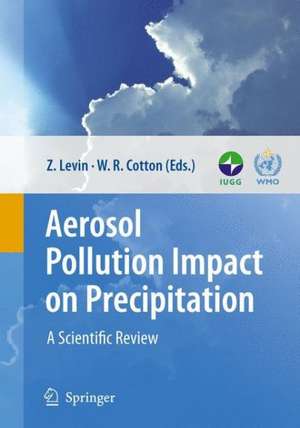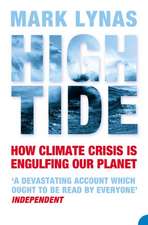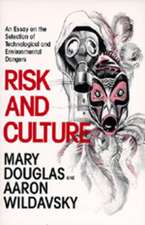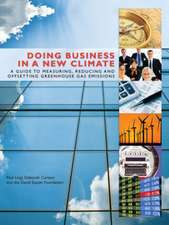Aerosol Pollution Impact on Precipitation: A Scientific Review
Editat de Zev Levin, William R. Cottonen Limba Engleză Paperback – 19 oct 2010
From an Earth Science perspective, a key question is how changes expected in climate will translate into changes in the hydrological cycle, and what trends may be expected in the future. We require a much better understanding and hence predictive capability of the moisture and energy storages and exchanges among the Earth’s atmosphere, oceans, continents and biological systems. This book is a review of our knowledge of the relationship between aerosols and precipitation reaching the Earth's surface and it includes a list of recommendations that could help to advance our knowledge in this area.
| Toate formatele și edițiile | Preț | Express |
|---|---|---|
| Paperback (1) | 793.67 lei 38-45 zile | |
| SPRINGER NETHERLANDS – 19 oct 2010 | 793.67 lei 38-45 zile | |
| Hardback (1) | 957.62 lei 6-8 săpt. | |
| SPRINGER NETHERLANDS – 7 oct 2008 | 957.62 lei 6-8 săpt. |
Preț: 793.67 lei
Preț vechi: 1044.31 lei
-24% Nou
Puncte Express: 1191
Preț estimativ în valută:
151.87€ • 162.40$ • 126.63£
151.87€ • 162.40$ • 126.63£
Carte tipărită la comandă
Livrare economică 14-21 aprilie
Preluare comenzi: 021 569.72.76
Specificații
ISBN-13: 9789048179534
ISBN-10: 904817953X
Pagini: 408
Ilustrații: XXI, 386 p. 108 illus., 71 illus. in color.
Dimensiuni: 155 x 235 x 21 mm
Greutate: 0.57 kg
Ediția:Softcover reprint of hardcover 1st ed. 2009
Editura: SPRINGER NETHERLANDS
Colecția Springer
Locul publicării:Dordrecht, Netherlands
ISBN-10: 904817953X
Pagini: 408
Ilustrații: XXI, 386 p. 108 illus., 71 illus. in color.
Dimensiuni: 155 x 235 x 21 mm
Greutate: 0.57 kg
Ediția:Softcover reprint of hardcover 1st ed. 2009
Editura: SPRINGER NETHERLANDS
Colecția Springer
Locul publicării:Dordrecht, Netherlands
Public țintă
ResearchCuprins
Principles of Cloud and Precipitation Formation.- Sources and Nature of Atmospheric Aerosols.- The Distribution of Atmospheric Aerosols: Transport, Transformation and Removal.- In Situ and Remote Sensing Techniques for Measuring Aerosols, Clouds and Precipitation.- Effects of Pollution and Biomass Aerosols on Clouds and Precipitation: Observational Studies.- Effects of Pollution Aerosol and Biomass Burning on Clouds and Precipitation: Numerical Modeling Studies.- Parallels and Contrasts Between Deliberate Cloud Seeding and Aerosol Pollution Effects.- Summary.- Recommendations.
Textul de pe ultima copertă
Life on Earth is critically dependent upon the continuous cycling of water between oceans, continents and the atmosphere. Precipitation (including rain, snow, and hail) is the primary mechanism for transporting water from the atmosphere back to the Earth's surface. It is also the key physical process that links aspects of climate, weather, and the global hydrological cycle. Changes in precipitation regimes and the frequency of extreme weather events, such as floods, droughts, severe ice/snow storms, monsoon fluctuations and hurricanes are of great potential importance to life on the planet. One of the factors that could contribute to precipitation modification is aerosol pollution from various sources such as urban air pollution and biomass burning. Natural and anthropogenic changes in atmospheric aerosols might have important implications for precipitation by influencing the hydrological cycle, which in turn could feed back to climate changes.
From an Earth Science perspective, a key question is how changes expected in climate will translate into changes in the hydrological cycle, and what trends may be expected in the future. We require a much better understanding and hence predictive capability of the moisture and energy storages and exchanges among the Earth’s atmosphere, oceans, continents and biological systems. This book is a review of our knowledge of the relationship between aerosols and precipitation reaching the Earth's surface and it includes a list of recommendations that could help to advance our knowledge in this area.
From an Earth Science perspective, a key question is how changes expected in climate will translate into changes in the hydrological cycle, and what trends may be expected in the future. We require a much better understanding and hence predictive capability of the moisture and energy storages and exchanges among the Earth’s atmosphere, oceans, continents and biological systems. This book is a review of our knowledge of the relationship between aerosols and precipitation reaching the Earth's surface and it includes a list of recommendations that could help to advance our knowledge in this area.
Caracteristici
A comprehensive review of the effects of aerosol pollution, including biomass burning, on precipitation Each article is written by experts who discuss in detail the most recent findings in the field The report identifies areas that need further study and includes recommendations for future research







